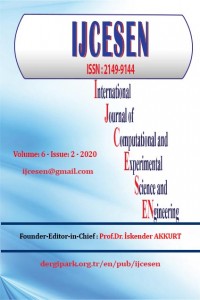Öz
Kaynakça
- Alvarez, J.O., Schechter, D.S., (2016). Altering Wettability in Bakken Shale by Surfactant Additives and Potential of Improving Oil Recovery During Injection of Completion Fluids. Presented at the SPE Improved Oil Recovery Conference, Society of Petroleum Engineers. https://doi.org/10.2118/179688-MS
- He, Y., Cheng, S., Li, S., Huang, Y., Qin, J., Hu, L., Yu, H., (2017). A Semianalytical Methodology To Diagnose the Locations of Underperforming Hydraulic Fractures Through Pressure-Transient Analysis in Tight Gas Reservoir. SPE J. 22, 924–939. https://doi.org/10.2118/185166-PA
- Liang, T., Achour, S.H., Longoria, R.A., DiCarlo, D.A., Nguyen, Q.P., (2016). Identifying and Evaluating Surfactant Additives to Reduce Water Blocks after Hydraulic Fracturing for Low Permeability Reservoirs. Presented at the SPE Improved Oil Recovery Conference, Society of Petroleum Engineers. https://doi.org/10.2118/179601-MS
- Liang, T., Li, Q., Liang, X., Yao, E., Wang, Y., Li, Y., Chen, M., Zhou, F., Lu, J., (2018). Evaluation of liquid nanofluid as fracturing fluid additive on enhanced oil recovery from low-permeability reservoirs. J. Pet. Sci. Eng. 168, 390–399. https://doi.org/10.1016/j.petrol.2018.04.073
- Liang, T., Luo, X., Nguyen, Q., DiCarlo, D.A., (2017a). Computed-Tomography Measurements of Water Block in Low-Permeability Rocks: Scaling and Remedying Production Impairment. SPE J. https://doi.org/10.2118/189445-PA
- Liang, T., Zhou, F., Lu, J., (2017b). Evaluation of wettability alteration and IFT reduction on mitigating water blocking for low-permeability oil-wet rocks after hydraulic fracturing. Fuel 209, 650–660. https://doi.org/10.1016/j.fuel.2017.08.029
- Meng, M., Ge, H., Ji, W., Wang, X., (2016). Research on the auto-removal mechanism of shale aqueous phase trapping using low field nuclear magnetic resonance technique. J. Pet. Sci. Eng. 137, 63–73. https://doi.org/10.1016/j.petrol.2015.11.012
- Penny, G.S., Zelenev, A., Lett, N., Paktinat, J., O&apos, Neil, B.J., (2012a). Nano Surfactant System Improves Post Frac Oil and Gas Recovery in Hydrocarbon Rich Gas Reservoirs. Presented at the SPE Improved Oil Recovery Symposium, Society of Petroleum Engineers. https://doi.org/10.2118/154308-MS
- Penny, G.S., Zelenev, A.S., Long, W., Lett, N.L., Crafton, J.W., (2012b). Laboratory and Field Evaluation of Proppants and Surfactants used in Fracturing of Hydrocarbon Rich Gas Reservoirs. Presented at the SPE Annual Technical Conference and Exhibition, Society of Petroleum Engineers. https://doi.org/10.2118/159692-MS
Mechanism of Using Dilute Microemulsion System (DMS) on Enhancing Hydrocarbon Production from Low Permeability Reservoirs
Öz
Dilute microemulsion system (DMS) can reduce the adsorption of surfactants on the rock surface, and it has been widely used as fracturing fluid additive for low permeability reservoirs in recent years. In some cases, it can reduce the water block caused by the invaded fracturing fluid and enhance the hydrocarbon production rate; while in some cases, it cannot. Although a few theories and models have been proposed to explain this discrepancy, it is still unclear (1) when DMS can enhance the hydrocarbon production, and (2) the impact of using DMS on hydraulic fracturing, flowback, and production. In this study, the imbibition test, contact angle test, and core flooding experiment were conducted to explore the answers to the above questions. Results from imbibition cell tests and contact angle measurements indicate our DMS can alter rock wettability from oil-wet to water-wet within half a day, but it cannot alter water-wet originally rocks. In core flooding experiments, the invasion step shows that the relative permeability to water is reduced after using DMS, suggesting DMS can reduce the forced water invasion during hydraulic fracturing; the flowback step shows that 0.1wt% DMS can reduce the water block and enhance the production rate by 12% comparing to the brine.
Anahtar Kelimeler
Kaynakça
- Alvarez, J.O., Schechter, D.S., (2016). Altering Wettability in Bakken Shale by Surfactant Additives and Potential of Improving Oil Recovery During Injection of Completion Fluids. Presented at the SPE Improved Oil Recovery Conference, Society of Petroleum Engineers. https://doi.org/10.2118/179688-MS
- He, Y., Cheng, S., Li, S., Huang, Y., Qin, J., Hu, L., Yu, H., (2017). A Semianalytical Methodology To Diagnose the Locations of Underperforming Hydraulic Fractures Through Pressure-Transient Analysis in Tight Gas Reservoir. SPE J. 22, 924–939. https://doi.org/10.2118/185166-PA
- Liang, T., Achour, S.H., Longoria, R.A., DiCarlo, D.A., Nguyen, Q.P., (2016). Identifying and Evaluating Surfactant Additives to Reduce Water Blocks after Hydraulic Fracturing for Low Permeability Reservoirs. Presented at the SPE Improved Oil Recovery Conference, Society of Petroleum Engineers. https://doi.org/10.2118/179601-MS
- Liang, T., Li, Q., Liang, X., Yao, E., Wang, Y., Li, Y., Chen, M., Zhou, F., Lu, J., (2018). Evaluation of liquid nanofluid as fracturing fluid additive on enhanced oil recovery from low-permeability reservoirs. J. Pet. Sci. Eng. 168, 390–399. https://doi.org/10.1016/j.petrol.2018.04.073
- Liang, T., Luo, X., Nguyen, Q., DiCarlo, D.A., (2017a). Computed-Tomography Measurements of Water Block in Low-Permeability Rocks: Scaling and Remedying Production Impairment. SPE J. https://doi.org/10.2118/189445-PA
- Liang, T., Zhou, F., Lu, J., (2017b). Evaluation of wettability alteration and IFT reduction on mitigating water blocking for low-permeability oil-wet rocks after hydraulic fracturing. Fuel 209, 650–660. https://doi.org/10.1016/j.fuel.2017.08.029
- Meng, M., Ge, H., Ji, W., Wang, X., (2016). Research on the auto-removal mechanism of shale aqueous phase trapping using low field nuclear magnetic resonance technique. J. Pet. Sci. Eng. 137, 63–73. https://doi.org/10.1016/j.petrol.2015.11.012
- Penny, G.S., Zelenev, A., Lett, N., Paktinat, J., O&apos, Neil, B.J., (2012a). Nano Surfactant System Improves Post Frac Oil and Gas Recovery in Hydrocarbon Rich Gas Reservoirs. Presented at the SPE Improved Oil Recovery Symposium, Society of Petroleum Engineers. https://doi.org/10.2118/154308-MS
- Penny, G.S., Zelenev, A.S., Long, W., Lett, N.L., Crafton, J.W., (2012b). Laboratory and Field Evaluation of Proppants and Surfactants used in Fracturing of Hydrocarbon Rich Gas Reservoirs. Presented at the SPE Annual Technical Conference and Exhibition, Society of Petroleum Engineers. https://doi.org/10.2118/159692-MS
Ayrıntılar
| Birincil Dil | İngilizce |
|---|---|
| Konular | Mühendislik |
| Bölüm | Research Articles |
| Yazarlar | |
| Yayımlanma Tarihi | 31 Temmuz 2020 |
| Gönderilme Tarihi | 7 Temmuz 2019 |
| Kabul Tarihi | 13 Temmuz 2020 |
| Yayımlandığı Sayı | Yıl 2020 Cilt: 6 Sayı: 2 |

